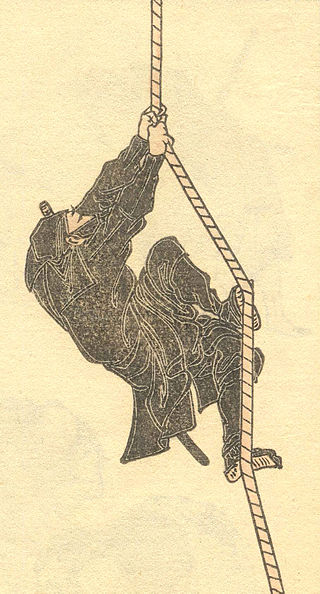
A ninja or shinobi was a covert agent, mercenary, or guerrilla warfare expert in feudal Japan. The functions of a ninja included siege and infiltration, ambush, reconnaissance, espionage, deception, and later bodyguarding and their fighting skills in martial arts, including ninjutsu. Their covert methods of waging irregular warfare were deemed dishonorable and beneath the honor of the samurai. Though shinobi proper, as specially trained warriors, spies, and mercenaries, appeared in the 15th century during the Sengoku period, antecedents may have existed as early as the 12th century.

Ninjutsu (忍術), sometimes used interchangeably with the modern term ninpō (忍法), is the martial art strategy and tactics of unconventional warfare, guerrilla warfare and espionage purportedly practised by the ninja. Ninjutsu was a separate discipline in some traditional Japanese schools, which integrated study of more conventional martial arts (taijutsu) along with shurikenjutsu, kenjutsu, sōjutsu, bōjutsu and others.
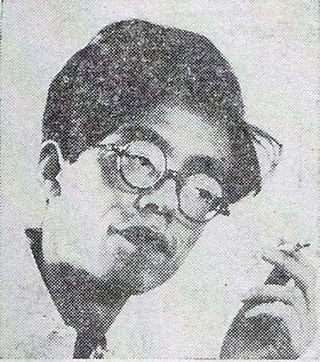
Futaro Yamada was the pen name of Seiya Yamada, a Japanese author. He was born in Yabu, Hyogo. In 1947, he wrote a mystery short story Daruma-tōge no Jiken and was awarded a prize by the magazine Houseki (宝石). He was discovered by Edogawa Rampo and became a novelist. He wrote many ninja and mystery stories. Many of his works have been adapted for film, TV, manga, and anime.

Ren Osugi, born Takashi Osugi was a Japanese actor. For his work in Cure, Hana-bi and other films, Osugi was given the Best Supporting Actor award at the 1999 Yokohama Film Festival. He often worked alongside Takeshi Kitano and Susumu Terajima. In the DVD commentary to the MPD Psycho television series, director Takashi Miike said that he admired Osugi's experience to shift quickly from comic and imbecilic to authoritative and earnest. He died of heart failure at the age of 66 on February 21, 2018.
Kōga-ryū is an umbrella term for a set of traditions of ninjutsu that originated from the region of Kōga. The samurai of Kōga-ryū were known as "Kōga-no-mono", and operated as shinobi throughout Japan's turbulent Sengoku period.
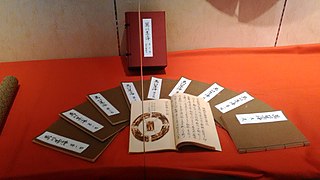
Bansenshūkai is a Japanese book containing a collection of knowledge from the clans in the Iga and Kōga regions that had been devoted to the training of ninja. Bansenshūkai summarizes the main points of the three volumes of the original Ninjutsu book Kanrinseiyō (間林清陽), and was written by selecting only those that fit the times. In the beginning of Bansenshūkai, the existence of the original text Kanrinseiyō was mentioned, but its existence had not been confirmed for a long time. However, in June 2022, a manuscript of the second volume of Kanrinseiyō copied in 1748 was found.
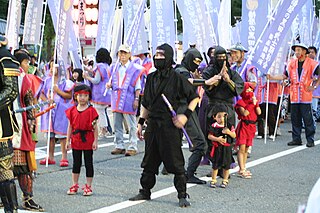
In the history of Japan, ninja operated as spies, assassins, or thieves; they formed their own caste outside the usual feudal social categories such as lords, samurai, and serfs. Ninja often appear as stock characters in Japanese popular culture and in global popular culture.
The Imperial Japanese Army Nakano School was the primary training center for military intelligence operations by the Imperial Japanese Army during World War II.
Kunoichi is a Japanese cant term for "woman". In popular culture, it is often used for female shinobi or practitioner of ninjutsu (ninpo). The term was largely popularized by novelist Yamada Futaro in his novel Ninpō Hakkenden (忍法八犬伝) in 1964.
Mochizuki Chiyome, also known as Mochizuki Chiyojo or Mochizuki Chiyo, was a 16th-century Japanese poet and noblewoman. She is known for allegedly creating a group of kunoichi in service of the Takeda clan.
Modern schools of ninjutsu are schools which offer instruction in martial arts. To a larger or smaller degree, the curriculum is derived from the practice of ninjutsu, the arts of the Shinobi; covert agents of feudal Japan.

Seiko Fujita, born Isamu Fujita, was a prominent Japanese martial artist, researcher and author. Regarded as the 14th and final heir to the Kōga-ryū Wada-ha Ninjutsu tradition, he was highly respected by his peers and a core member of Japan's classical martial arts community.
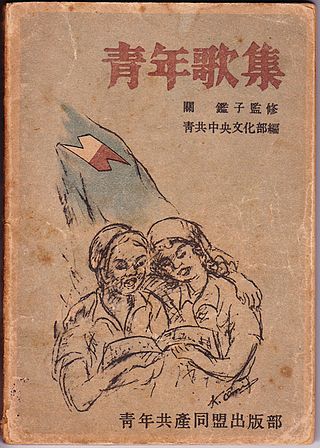
The Singing Voice of Japan is the name of a social and political movement that emerged after World War II in Japan and based on musical and choral activities of the working class of the entire nation. On the ideological position of communism or democratic socialism, activists of the movement organize choral circles in factories, in schools and in their residential areas. The movement reached its peak in the years 1950–60. Japanese singer Akiko Seki is generally regarded as the founder of the Singing Voice of Japan.
Denrinbō Raikei , also known as Benkei Musō was Chinese-born Japanese martial artist, ninja, swordsman, and Yamabushi. He belonged to Hitoyoshi Domain as ninja. He was thought to be the head of ninja group, Ura-Taisha(裏タイ捨) or Sagara-ningun(相良忍軍).
This article lists non-Japanese people who were ninja, or similar covert agents influenced by ninja.
Ninja-Russia relation refers to the international relations between the Ninja, Japanese covert agents, and historical Russian countries such as the Russian Empire and the Soviet Union. Russia was the first western country that ninja confronted and among the earliest countries that recognized the existence of ninja and researched them.
The Order of Musashi Shinobi Samurai is a Japanese shinobisamurai clan which served Tokugawa Ieyasu and the Edo Shogunate from 1582 to 1868. They served the Tokugawa Shogunate as intelligence operatives called onmitsu, and metsuke (inspectors), and in the 19th century, as diplomats. When the political system changed due to the restoration of the monarchy in 1868, it became independent. The order consists of a number of families and people who have built close relations of trust with the Shibata Clan of the Musashi Province.
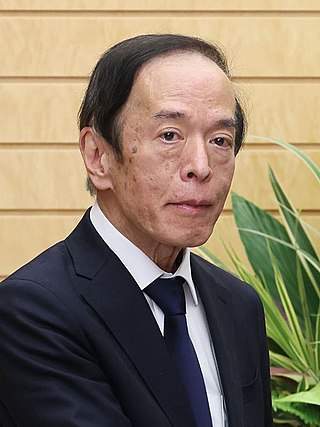
Kazuo Ueda is a Japanese economist who has served as the 32nd Governor of the Bank of Japan (BOJ) since April 2023.








